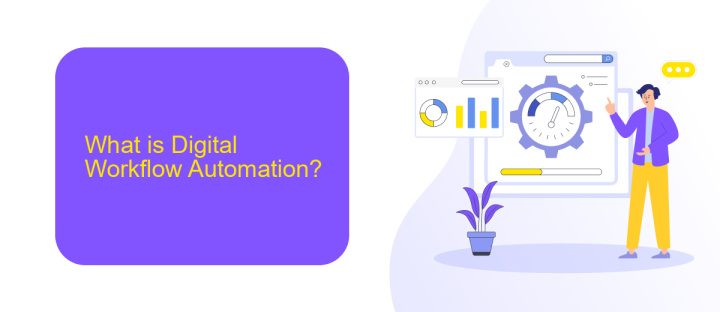What is Digital Workflow Automation
Digital Workflow Automation refers to the use of technology to streamline and automate business processes, reducing the need for manual intervention. By leveraging software tools and applications, organizations can enhance efficiency, minimize errors, and accelerate task completion. This article explores the fundamentals of digital workflow automation, its benefits, and how it can transform traditional business operations into more agile and responsive systems.
Introduction
Digital Workflow Automation is revolutionizing the way businesses operate by streamlining processes and reducing manual tasks. This technology leverages software tools to automate repetitive tasks, ensuring efficiency and accuracy. By integrating various applications and systems, Digital Workflow Automation creates a seamless flow of information, enhancing productivity and decision-making.
- Improved efficiency through task automation
- Enhanced accuracy by reducing human error
- Seamless integration of various applications
- Real-time data synchronization and updates
- Increased productivity and better decision-making
One of the key tools in setting up these integrations is ApiX-Drive, a service that simplifies the connection between different applications without requiring extensive coding knowledge. With ApiX-Drive, businesses can automate workflows and ensure data flows smoothly between platforms, allowing teams to focus on more strategic tasks rather than mundane, repetitive ones. Embracing Digital Workflow Automation is essential for modern businesses aiming to stay competitive in a fast-paced digital landscape.
What is Digital Workflow Automation?

Digital Workflow Automation refers to the use of technology to streamline and automate complex business processes. By leveraging software tools, businesses can reduce manual intervention, minimize errors, and enhance efficiency. This automation can encompass various functions, from document management and data entry to customer relationship management and beyond. By automating repetitive tasks, employees can focus on more strategic activities, ultimately driving productivity and growth.
One key aspect of digital workflow automation is the integration of different systems and applications. Tools like ApiX-Drive facilitate seamless integration by connecting various software and platforms, enabling data to flow effortlessly between them. This not only saves time but also ensures data consistency and accuracy. By employing such integration services, businesses can create a cohesive and efficient digital ecosystem, optimizing their operations and improving overall performance.
Benefits of Digital Workflow Automation

Digital workflow automation offers numerous advantages that can significantly enhance business processes and overall efficiency. By automating repetitive tasks, organizations can focus on more strategic activities, reducing the likelihood of human error and increasing productivity.
- Time Savings: Automating manual tasks speeds up processes, allowing employees to dedicate their time to more valuable work.
- Cost Reduction: By minimizing the need for manual labor, companies can reduce operational costs and allocate resources more effectively.
- Improved Accuracy: Automation reduces human error, ensuring data consistency and reliability.
- Enhanced Collaboration: Digital workflows facilitate better communication and coordination among team members, streamlining project management.
- Scalability: Automated systems can easily scale with business growth, accommodating increasing workloads without additional strain.
Furthermore, services like ApiX-Drive simplify the integration of various applications and software, enabling seamless data transfer and synchronization. This not only enhances workflow efficiency but also ensures that all systems are up-to-date and working in harmony. By leveraging digital workflow automation, businesses can achieve greater agility and maintain a competitive edge in the market.
Examples of Digital Workflow Automation

Digital workflow automation streamlines various business processes by reducing manual intervention and increasing efficiency. One common example is the automation of customer support through chatbots. These AI-powered bots can handle routine inquiries, freeing up human agents for more complex issues.
Another example is in the realm of marketing, where automated email campaigns can be triggered based on user behavior. This ensures timely and relevant communication with potential customers, enhancing engagement and conversion rates.
- Automated invoice processing: Reduces errors and speeds up the payment cycle.
- HR onboarding: Streamlines the process of integrating new employees by automating document submissions and training schedules.
- Data integration: Tools like ApiX-Drive facilitate seamless data transfer between different software applications, enhancing workflow efficiency.
By leveraging digital workflow automation, businesses can not only save time but also improve accuracy and consistency across various operations. As technology continues to evolve, the possibilities for automating complex workflows will only expand, providing even greater opportunities for efficiency and innovation.
- Automate the work of an online store or landing
- Empower through integration
- Don't spend money on programmers and integrators
- Save time by automating routine tasks
How to Implement Digital Workflow Automation
Implementing digital workflow automation begins with a thorough assessment of your existing processes. Identify repetitive tasks and areas where manual intervention can be minimized. Document these workflows and prioritize them based on their impact on efficiency and productivity. Once you have a clear understanding, select a suitable automation tool that aligns with your needs. Ensure the tool is user-friendly and compatible with your existing systems to facilitate a smooth transition.
Next, focus on integrating your chosen automation tool with other essential software and services. ApiX-Drive, for instance, offers seamless integration capabilities, allowing you to connect various applications without any coding knowledge. This streamlines data flow and ensures consistency across platforms. After setting up integrations, test the automated workflows thoroughly to identify any issues. Monitor performance regularly and make necessary adjustments to optimize efficiency. Providing adequate training for your team will ensure they can effectively leverage the new system, leading to successful implementation of digital workflow automation.
FAQ
What is Digital Workflow Automation?
How does Digital Workflow Automation benefit businesses?
What types of processes can be automated?
How do I start implementing Digital Workflow Automation in my business?
What should I consider when choosing a Digital Workflow Automation tool?
Strive to take your business to the next level, achieve your goals faster and more efficiently? Apix-Drive is your reliable assistant for these tasks. An online service and application connector will help you automate key business processes and get rid of the routine. You and your employees will free up time for important core tasks. Try Apix-Drive features for free to see the effectiveness of the online connector for yourself.


